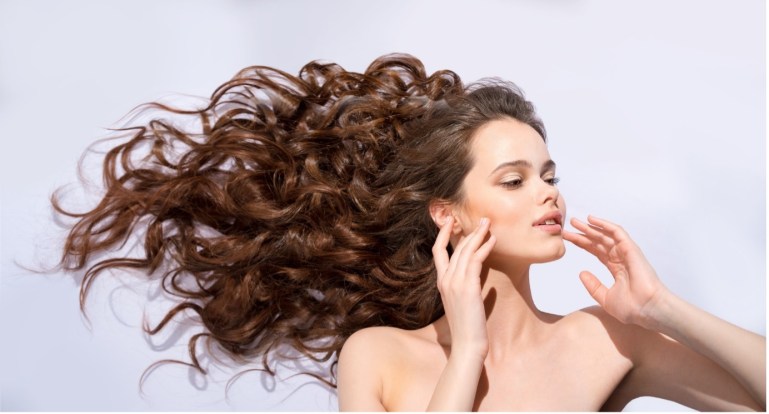The “curly girl method” exploded in popularity in 2020, primarily thanks to the boredom of lockdowns and the rise in TikTok users.
But, whether you’re familiar with the curly girl method or not, learning how to look after your hair is never a bad thing. Indeed, many people don’t even realize there are classifications of different types of curly hair.
If the phrases 2a, 3b, and 4c mean nothing to you, you’ve come to the right place. We’ll teach you everything there is to know about curly hair classifications, how to recognize which type your hair is, and how to manage it.
Read on to learn more.
Type 2: Waves
Type 2 hair is what you’d typically call “wavy” hair. It’s very much an in-between sort of hair as it isn’t straight or curly. Generally, type 2 hair is easy to manage as it falls in loose S shapes.
There are three categories of type 2 hair. These are:
- Type 2a
- Type 2b
- Type 2c
Type 2a is fine with a very loose S wave; this is the easiest type to manage. Type 2a people can achieve the effortless “I woke up like this” look without much styling.
Type 2b is slightly thicker and has a more defined S shape. If you’re a type 2b, you might notice your hair gets frizzy quickly.
Type 2c is the curliest in the ‘wavy’ range with a prominent S shape, and without adequately styling tools, it can look messy.
How to Manage Type 2 Hair
Type 2 hair masquerades as easy to manage, and yet, as it’s so prone to frizz it can be challenging to keep your waves defined without extra measures.
A medium or long one-length haircut is best for this type of hair because layering can make your hair look thin.
To reduce frizz, you should skip towel drying as it can damage the keratin bonds. Instead, either let it drip dry or use a diffuser. Alternatively, if you’re attached to towel drying, you should invest in a microfiber towel for curly hair.
Finally, stop using regular hairbrushes because these are some of the worst things for frizzy hair. Either use a wide-tooth comb or scrunch your hair into position.
Type 3: Curls
Type 3 hair is your classic curls; you’ll have beautiful locks in either S shapes or Z shapes. Type 3a curls are generally tight with minimal thickness or volume, so this makes it easy to style.
Type 3b curls are a ringlet shape with lots of volume. Curls are about as wide as a tapered candlestick and are tight and springy. If you have type 3b hair, you’ll notice a lot of shrinkage as your hair dries. Type 3b is easy to style if you know how but requires significant effort.
Finally, type 3c curls are corkscrew-shaped and very tight. Natural oils on your scalp struggle to travel into the hair, which means it’s prone to dryness.
How to Manage Type 3 Hair
If you have type 3 hair, you’ve got the potential to have show-stopping curls. However, if you’re complacent about your hair-care routine, it may look like a dry, frizzy mess.
You should use deep conditioning hair masks to moisturize your hair and let it soften into its natural curls. Be wary of strong gels and sprays because they can lead to damage to the follicle.
The key to managing type 3 hair is moisture, so leave-in conditioners, serums, and hair masks should be your best friend.
Type 4: Coils
If you were wondering how many types of curly hair were to come, this is the last one. Type 4 hair is your tight coils in an afro; it’s most common for black people.
Type 4 hair is striking and forms coils. However, it’s kinky and extremely fragile. It’s very prone to dryness, and this means you may have breakage.
You can tell if you have type 4a hair because it’ll form an S shape if you stretch it. Untouched, it’ll resemble visible spirals that look as if they’ve been coiled around a knitting needle.
Type 4b resembles fluffy cotton and doesn’t have a defined curl structure. Curls for a Z rather than an S and have loads of volume. Type 4b hair experiences shrinkage of up to 70%, so it often appears short even when it’s not.
Finally, type 4c is the curliest and coiled hair of all; there is no defined curl pattern. It looks very similar to 4b hair but is more tightly packed.
How to Manage Type 4 Hair
Type 4 hair requires the most attention to keep it in good health because it’s so prone to breakage. 4a hair can be styled using gels and mouses. However, weaves and other protective hairstyles are popular for type 4b and 4c people.
You should pay extra attention to caring for your type 4 hair; use a sulfate-free shampoo, jojoba oil, and tea tree oil. Finally, use leave-in moisturizing hair masks overnight on each wash day to help cement extra moisture into your locks.
Type 4 hair requires the most care but can also be the most rewarding to style.
Types of Curly Hair Explained
That’s everything you need to know about all types of curly hair. Whether you’re a beachy type 2 or a striking type 4, all curls are great curls.
Recognizing that there are several types of curly hair and understanding they need to be treated differently is the first step to cracking your hair care. So, capitalize on your incredible genes and make your curls turn heads. Soon, everyone will be wanting the details of your hair care routine.
Did you find this article helpful? If so, make sure to check out the rest of our page for more health, beauty, and lifestyle hacks.

